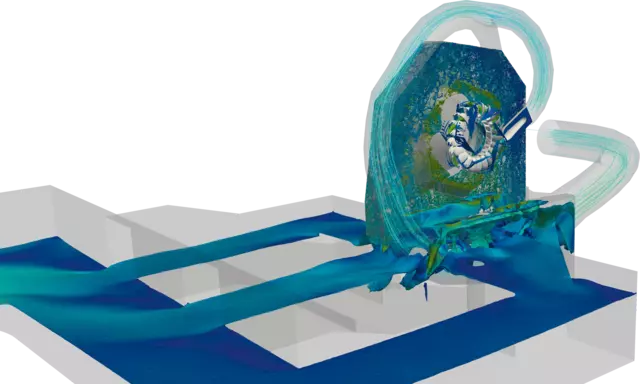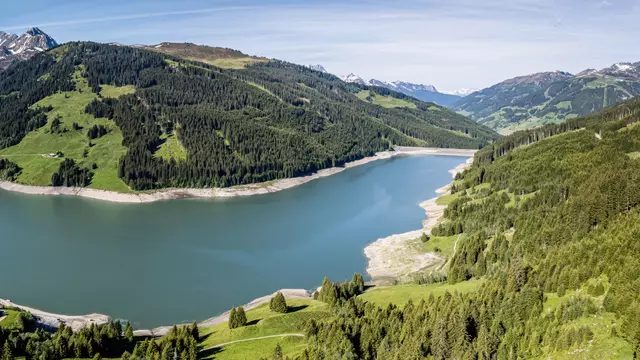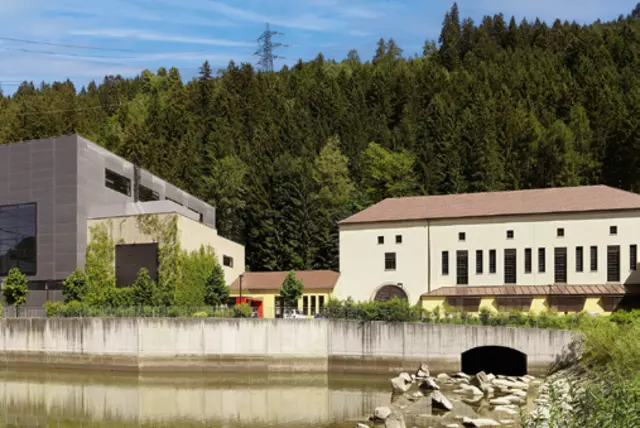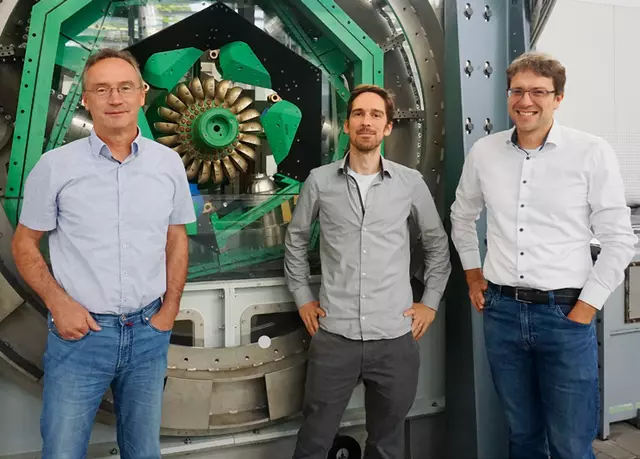
Groundbreaking innovation in hydropower
Horizontally revolutionary
Voith Hydro is setting new standards with the first horizontal, six-nozzle Pelton turbine

1 Two-part distribution channel.
2 Jet protection roof.
3 Cone for water discharge.
One particular challenge has kept Voith Hydro’s development engineers busy for more than 10 years: What if we could arrange Pelton turbines with three or more nozzles horizontally without sacrificing performance, instead of vertically, as is the norm today?
Wouldn’t this make maintenance work and repairs much easier and safer? In addition, it would be possible to replace turbines without major structural works in the event of a plant modernization. Furthermore, new plants would require less excavation work and a smaller footprint.
The first Pelton turbines were positioned horizontally and equipped with one or two nozzles. If they were built with more nozzles, however, the backsplashing water slowed down the runner and thus reduced the turbine’s efficiency. In order to be able to use more nozzles and thereby increase output, turbines with vertical shafts were therefore installed from the 1950s onwards. In this arrangement, the water discharged by the buckets can be drained upwards and downwards without much effort.
“We asked ourselves how we could combine the advantages of a horizontal shaft with those of a sixnozzle arrangement,” explains Reiner Mack, a development engineer at Voith Hydro. It quickly became clear to him that the only way to install more nozzles in a horizontal turbine was to improve the water management.

Durlaßboden reservoir, Zillertal valley in Tyrol, Austria: This picturesque landscape is the scene of a groundbreaking innovation in hydropower.
Using existing space more effectively
But how could this challenge be solved horizontally? Mack describes Voith Hydro’s approach like this: “We effectively utilize the available space by using a cone that acts both as a baffle plate for the outflowing water and as a drain for the water that would fall back onto the runner without the cone.” This prevents the runner from being slowed down by water splashing back onto it.
The implementation of this concept in the real world was preceded by complex simulations and model tests. “The interaction between the water jet and the buckets of the Pelton wheel is extremely short, often just a few milliseconds,” explains Peter Mössinger, responsible for the Pelton turbines’ numerical flow simulation.
This is why numerical forecasting of the bucket flow is extremely complex and requires a great deal of effort. “In addition, we refined the methods in recent years so that we can now also analyze the housing flow or the water flow downstream of the turbine. This progress played a significant role in the successful development of the new concept.”
But the model testing technology also faced new challenges. “The greatest difficulty our model machine designers faced was certainly ensuring that we had the flexibility to make advancements to the housing,” explains Mössinger. “Not all numerically developed versions prove themselves right away, which means that flexibility in the model machine is extremely important.”
HP3+
HP3+, which stands for a horizontal Pelton turbine with three or more nozzles, is the name given to this innovation by Voith Hydro. An increase in the number of nozzles results in an increase in power density and thus also in speed. As a result, both the generator and the turbine can be made smaller.

The flow simulation virtually displays, among other things, the turbulence of the backsplashing water.
Everything at the same height makes maintenance easier
Ultimately, the many years of research paid off, and the new concept has been able to meet expectations. Voith Hydro calls the innovation HP3+, which stands for horizontal Pelton turbines with three or more nozzles. Increasing the number of nozzles increases the power density and thus also the rotational speed. As a result, both the generator and turbine can be built smaller.
Mack sees another major advantage: “Servicing a horizontal machine is much easier than a vertical shaft because everything is on one level in a horizontal arrangement.” The maintenance team can stay on one floor and in the powerhouse environment when servicing the turbine and has a direct view of the overhead crane. When installing vertical arrangements, the installation team often has to work across several floors under makeshift lighting conditions using chain hoists. Accordingly, this requires much more effort to create a safe working environment. “Our colleagues from St. Pölten came up with a lot of ideas during the mechanical design work for the HP3+ in order to be able to service the turbine quickly and safely,” says Mössinger. “The result has likewise been innovative solutions that didn’t exist before.”
In addition, about 20 years ago, companies started to completely gut old powerhouses that were equipped with horizontal machines in order to then use vertical machines. This required dismantling the underwater channels and the entire infrastructure on site. Because the powerhouse is too low to properly perform maintenance on a vertical machine, however, this solution always remained a compromise. “When performing general maintenance, it is often necessary to tilt the entire generator and then dismantle the rotor in a horizontal position. This obviously involves a considerable amount of work,” explains Mack. When utilizing horizontal units, this effort is, of course, no longer required. Construction measures are also much more modest, as the new horizontal machines can, ideally, be placed on top of the existing foundations.

Pilot project at the Gerlos 1 storage power plant in the Zillertal valley in Tyrol
The new turbine was presented to the public for the first time at a leading international hydropower conference in Vienna. The concept generated a great deal of interest there from hydropower operators. The exciting question was then how the new turbine would prove itself in practice. The corresponding pilot project was already underway. This was because Voith Hydro had already found a suitable company that had the necessary pioneering spirit, courage and technical understanding required for the new solution.
The candidate that met these requirements is none other than Austria’s leading energy transition company Verbund. It operates the Gerlos 1 storage power plant in the Zillertal valley in Tyrol. This plant was brought into operation in 1949 and now has an annual capacity of 326 GWh. As a result, the power plant supplies over 70,000 fourperson households with renewable energy, as the first six-nozzle horizontal Pelton turbine has been successfully in operation here since October 2022. It replaced the four two-nozzle vertical machines previously installed.
Although the equipment itself is more expensive with the horizontal solution, customers save that much more when it comes to construction costs. This is because the turbine can be replaced without major construction work, which saves a massive amount of time and money. And the fact that fewer machines are in operation also reduces maintenance costs in the future.

Gerlos hydropower plants, waterway longitudinal section

The two powerhouses Gerlos I (right) and Gerlos II in the Zillertal.
Perfect for modernization projects
The pilot project also clearly shows why the horizontal arrangement of the Pelton turbines particularly benefits modernization projects: “At the Gerlos 1 plant, four very old vertical turbines were replaced with one horizontal unit because the powerhouse ceiling was too low and the powerhouse area was too small for a vertical one,” Mack explains.
The specification originally envisaged a conventional twin unit with one generator and two two-nozzle turbines each. There simply wasn’t enough installation space for this solution, however. “For our HP3+ solution, we were able to gain valuable space by developing the inlet numerically,” Mössinger adds. “This ensured that the unit would be well positioned in the powerhouse for all maintenance operations.”
These advantages are also proving their merits in a second pilot project at the Vermuntwerk plant in Vorarlberg, which is operated by Illwerke. Here, five two-nozzle units are being replaced by two turbines with six nozzles – while total plant capacity will remain the same. “Two turbines means you only have to maintain two runners and two generators and also only two transformers, instead of five like before. This will significantly reduce maintenance costs.”
Mack has been involved in the development of this innovative solution from the very beginning. “It was great seeing the first prototype of an HP3+ installed and then in operation.” To him, one thing is abundantly clear: “On the one hand, developing a solution like this requires members of management at Voith who have the necessary vision to see that such an idea will be successful. On the other hand, confidence in our solution on the part of customers, which has grown over many years of continuous collaboration, is also necessary. At the end of the day, we want our customers to be satisfied with our turbines, that’s the main thing.”
The pilot project also clearly shows why the horizontal arrangement of the Pelton turbines particularly benefits modernization projects.
These advantages are also proving their merits in a second pilot project at the Vermuntwerk plant in Vorarlberg, which is operated by Illwerke. Here, five two-nozzle units are being replaced by two turbines with six nozzles.

Innovative turbine developers at Voith: Reiner Mack, Dr. Peter Mössinger and Dr. Jörg Necker.

For more than 100 years, Voith Hydro has developed, built and installed hydraulic machines for the development of hydropower. During this time, Voith Hydro has contributed significantly to the advancement of many types of hydropower turbines. Thousands of installed hydropower plants worldwide were provided with Voith Hydro turbines. The foundation of Voith Hydro's expertise is the accumulation of equipment operating results over time.
Learn more
We bring your hydropower plant up to highest reliability and digitalization. Modernizing an existing plant can be challenging. With our knowledge, we help you to develop and implement the best solution. As a reliable and experienced partner, we understand your needs and requirements and work with you to meet your targets.
Learn more
As a reliable partner for 150 years, Voith offers everything needed for the efficient and future-oriented creation of hydropower. The portfolio includes all components for large and small hydropower plants as well as for pumped storage power plants - from generators, turbines, pumps and automation systems to spare parts, maintenance and training services as well as digital solutions for the entire life cycle of the plants.
Learn more